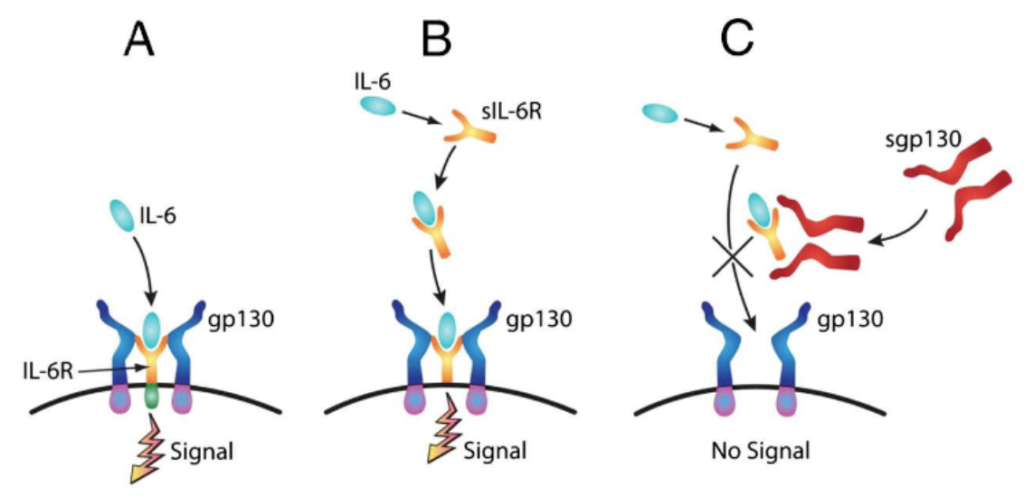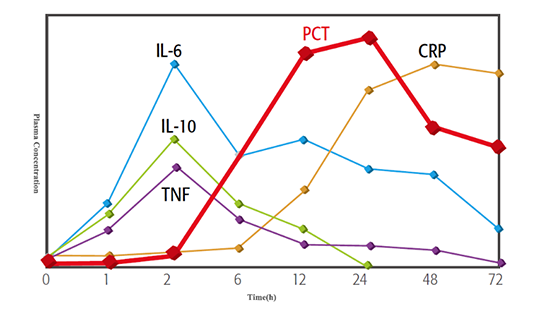Abstract: Interleukin-6(IL-6) is an important cytokine mainly produced by T cell and monocyte. It will be released during infection, tissue damage or inflammation, and also plays its role as proinflammatory cytokine and anti-inflammatory modulator. There are three types of IL-6 signaling pathway: classical signaling pathway, trans-signaling pathway and trans-presentation.
Keywords: IL-6 signaling pathway, cytokine, inflammation, Interleukin-6
1. IL-6 Signaling Pathway
In classical signaling pathway, IL-6 first binds with its receptor IL-6R to form the complex. Then, the complex binds with gp130 protein on the cell membrane, evoking the downstream signaling pathway and gene expression via activating intracellular signal transduction.
IL-6R exists in the soluble form. The binding affinity between SIL-6R and IL-6(IL-6R) is similar. The conjugate binds with gp130 to activate intracellular signal transduction.
Trans-presentation mainly happens in the antigen-specific interaction between dendritic cells offering IL-6 signaling and T cell receiving IL-6. IL-6 binds with IL-6 receptor in dendritic cells. The complex is transferred to plasma membrane and recognize T cell to phosphorylate STAT3 in the gp130 mediated T cell.

2. IL-6 in Inflammation Immunity and Disease
IL-6 has wide effects in inflammation, immune reaction and hematopoiesis. Role of IL-6 in hepatocyte induces the production of acute phase protein, e.g. C-reactive protein(CRP), complement C3, serum amyloid protein A(SAA), fibrinogen, thrombopoietin, hepcidin, haptoglobin, alpha-1-antichymotrypsin. Thus, IL-6 becomes the important mediator during acute phase response. However, higher concentration of SAA in the serum may cause severe complication, e.g. amyloidosis of amyloid protein A. Besides, IL-6 induced hepcidin production blocks the role of ferroportin 1 in intestine. The decrease of iron level in the serum causes chronic inflammation related iron deficiency anemia and anaemia. During hematopoiesis, IL-6 promotes the differentiation of hemopoietic stem cell, mature of megakaryocyte and release of blood platelet.
In the adaptive immune response, IL-6 also produces and induces the differentiation of CD4+ T cell into effector T cell via stimulating antibodies. Besides, IL-6 helps T cell in cell differentiation, production of IL-21 and regulation of immunoglobulin synthesis.
IL-6 induces bone marrow stromal cells to produce RANKL, promoting activation of osteoblast to increase angiogenesis and vascular permeability. IL-6 promotes coagulation cascade via inducing tissue factor, and improves vascular permeability of vascular endothelial cell. Besides, IL-6 accelerates vascular reactivity via increasing the expression of C5a receptor, possibly resulting in various pathological process, e.g. vasoconstriction and myocardial dysfunction.

3. IL-6 Clinical Trial
IL-6 is involved in the generation and development of various diseases. Its blood level is closely related to inflammation, virus infection and autoimmune diseases. In inflammatory response, the increase of IL-6 appears earlier than other factors(even earlier than CRP and PCT), and continues for a long time, thus assisting to early diagnosis of acute infection. Besides, IL-6 can be also applied in evaluating the severity of infection and prognosis. When the level of IL-6 is higher than 1000μg/L, prognosis is poor. However, the specificity of IL-6 is lower than PCT. PCT and CRP can compensate for its deficiencies.

4. Recommended Products
4.1. Recombinant Proteins
|
Cat.No |
Product Name |
M.W. |
Host |
|
Recombinant Human IL-6 |
20 kDa |
E.Coli |
|
|
Recombinant Human IL-6R |
47.9 kDa |
E.Coli |
|
|
Recombinant Mouse IL-6 |
20.5 kDa |
E.Coli |
|
|
Recombinant hamster IL-6 |
23.5 kDa |
E.Coli |
|
|
Recombinant Goat IL-6 |
22.3 kDa |
E.Coli |
|
|
Recombinant Canine IL-6 |
22.8 kDa |
E.Coli |
|
|
Recombinant Bovine IL-6 |
20.6 kDa |
E.Coli |
|
|
Recombinant Chicken IL-6 |
22 kDa |
E.Coli |
|
|
Recombinant Porcine IL-6 |
20.8 kD |
E.Coli |
4.2. Antibodies
|
Cat.No |
Product Name |
M.W. |
Antibody Type |
Applications |
|
IL6 antibody |
24 kDa |
Mouse mAb |
ELISA, WB |
|
|
IL6R antibody |
80 kDa |
Rabbit pAb |
ELISA, WB, IHC, IP |
4.3. ELISA Kits
|
Cat.No |
Product Name |
Range |
Sensitivity |
|
Human IL-6 QuickTest ELISA Kit |
0.46-30pg/ml |
0.28pg/ml |
|
|
Human IL-6 ELISA Kit |
0.313-20pg/ml |
0.188pg/ml |
|
|
Human IL-6 ELISA Kit |
4.688-300pg/ml |
2.813pg/ml |
|
|
Human HS-IL-6 Accquant ELISA Kit |
0.078-5pg/ml |
0.046pg/ml |
|
|
Human HS-IL-6 Accquant ELISA Kit |
0.46-30pg/ml |
0.28pg/ml |
|
|
Human anti-IL-6 antibody Elisa kit |
3.125-200ng/ml |
1.875ng/ml |
|
|
Mouse IL-6 QuickTest ELISA Kit |
3.125-200pg/ml |
1.875pg/ml |
|
|
Mouse IL-6 ELISA Kit |
15.625-1000pg/ml |
9.375pg/ml |
|
|
Mouse IL-6 ELISA Kit |
6.25-400pg/ml |
3.75pg/ml |
|
|
Mouse HS-IL-6 Accquant ELISA Kit |
6.25-400pg/ml |
3.75pg/ml |
|
|
Rat IL-6 ELISA Kit |
62.5-4000pg/ml |
37.5pg/ml |
|
|
Rat IL-6R ELISA Kit |
78.125-5000pg/ml |
46.875pg/ml |
|
|
Monkey IL-6 QuickTest ELISA Kit |
0.313-20pg/ml |
0.188pg/ml |
|
|
Monkey IL-6 ELISA Kit |
0.313-20pg/ml |
0.188pg/ml |
|
|
Monkey IL-6 ELISA Kit |
31.25-2000pg/ml |
18.75pg/ml |
|
|
Duck IL-6 ELISA Kit |
31.25-2000pg/ml |
18.75pg/ml |
|
|
Guinea pig IL-6 ELISA Kit |
15.625-1000pg/ml |
9.375pg/ml |
|
|
Porcine IL-6 ELISA Kit |
31.25-2000pg/ml |
18.75pg/ml |
|
|
Hamster IL-6 ELISA Kit |
7.813-500pg/ml |
4.688pg/ml |
|
|
Hamster IL-6 ELISA Kit |
1.563-100pg/ml |
0.938pg/ml |
|
|
Sheep IL-6 ELISA Kit |
7.813-500pg/ml |
4.688pg/ml |
|
|
Rabbit IL-6 ELISA Kit |
15.625-1000pg/ml |
9.375pg/ml |
|
|
Horse IL-6 ELISA Kit |
3.125-200pg/ml |
1.875pg/ml |
|
|
Chicken IL-6 ELISA Kit |
31.25-2000pg/ml |
18.75pg/ml |
|
|
Canine IL-6 ELISA Kit |
31.25-2000pg/ml |
18.75pg/ml |
|
|
Bovine IL-6 ELISA Kit |
31.25-2000pg/ml |
18.75pg/ml |
REFERENCES
[1]Hesperidin inhibits lung fibroblast senescence via IL-6/STAT3 signaling pathway to suppress pulmonary fibrosis, PMID: 36736168.
[2]Genetic perturbation of IL-6 receptor signaling pathway and risk of multiple respiratory diseases, PMID: 38898459.
